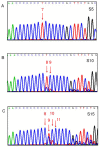Leukocyte mitochondrial DNA alteration in systemic lupus erythematosus and its relevance to the susceptibility to lupus nephritis
- PMID: 22942739
- PMCID: PMC3430270
- DOI: 10.3390/ijms13078853
Leukocyte mitochondrial DNA alteration in systemic lupus erythematosus and its relevance to the susceptibility to lupus nephritis
Abstract
The role of mitochondrial DNA (mtDNA) alterations in the pathophysiology of systemic lupus erythematosus (SLE) remains unclear. We investigated sequence variations in the D310 region and copy number change of mtDNA in 85 SLE patients and 45 normal subjects. Leukocyte DNA and RNA were extracted from leukocytes of the peripheral venous blood. The D310 sequence variations and copy number of mtDNA, and mRNA expression levels of mtDNA-encoded genes in leukocytes were determined by quantitative real-time polymerase chain reaction (Q-PCR) and PCR-based direct sequencing, respectively. We found that leukocyte mtDNA in SLE patients exhibited higher frequency of D310 heteroplasmy (69.4% vs. 48.9%, p = 0.022) and more D310 variants (2.2 vs. 1.7, p = 0.014) than those found in controls. Among normal controls and patients with low, medium or high SLE disease activity index (SLEDAI), an ever-increasing frequency of D310 heteroplasmy was observed (p = 0.021). Leukocyte mtDNA copy number tended to be low in patients of high SLEDAI group (p = 0.068), especially in those harboring mtDNA with D310 heteroplasmy (p = 0.020). Moreover, the mtDNA copy number was positively correlated with the mRNA level of mtDNA-encoded ND1 (NADH dehydrogenase subunit 1) (p = 0.041) and ATPase 6 (ATP synthase subunit 6) (p = 0.030) genes. Patients with more D310 variants were more susceptible to lupus nephritis (p = 0.035). Taken together, our findings suggest that decrease in the mtDNA copy number and increase in D310 heteroplasmy of mtDNA are related to the development and progression of SLE, and that the patients harboring more D310 variants of mtDNA are more susceptible to lupus nephritis.
Keywords: D310 sequence variation; copy number; heteroplasmy; mitochondrial DNA; systemic lupus erythematosus.
Figures



References
-
- Blank M., Shoenfeld Y., Perl A. Cross-talk of the environment with the host genome and the immune system through endogenous retroviruses in systemic lupus erythematosus. Lupus. 2009;18:1136–1143. - PubMed
-
- Perl A., Gergely P., Jr, Banki K. Mitochondrial dysfunction in T cells of patients with systemic lupus erythematosus. Int. Rev. Immunol. 2004;23:293–313. - PubMed
Publication types
MeSH terms
Substances
LinkOut - more resources
Full Text Sources

